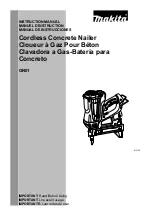
5
Do not use the tool unless you thoroughly under-
stand the actuation mode selected.
Remove battery pack and fasteners before leaving
the work area, moving the tool to another location,
or handing the tool to another person. Failure to do
so could result in serious injury.
Do not use this tool for fastening electrical
cables. It is not designed for electric cable
installation and may damage the insulation of
electric cables thereby causing electric shock
or fire hazards.
NEVER wedge or hold back the workpiece contact
mechanism during operation of the tool. Never
attempt to clear a jammed workpiece contact by
grasping the discharge area of the tool. Doing so
could result in serious injury.
To avoid serious injury, do not attempt to prevent
the recoil by holding the tool too firmly against
the work. Keep face and body away from the tool.
During normal use, the tool will recoil immediately
after driving a fastener. This is a normal function
of the tool. Restriction to the recoil can result in a
second fastener being driven when the tool is in
Contact Actuation mode. Grip the handle firmly,
let the tool do the work, and do not place a second
hand on top of the tool.
Power/Actuation Selection
1. Install battery pack.
2. Press and hold the Power/Actuation button to
turn on the tool.
Power/Actuation Button
Power
Indicator
Actuation
Indicator
3. Press the Power/Actuation button again to toggle
between single sequential actuation mode and
contact (bump) actuation mode.
WARNING!
Understand actuation process before use.
Single Sequential Actuation
-
Solid Light - The workpiece contact and
then the trigger must be activated in a
specific sequence to drive a fastener.
Contact (Bump) Actuation
-
Flashing Light - The workpiece contact
and the trigger can be activated in any
sequence to drive a fastener.
4. Press and hold the Power/Actuation button to
turn off the tool.
Single Sequential Actuation Operation
1. Grip the handle firmly.
2. Push the tool against the work surface, compressing
the workpiece contact.
3. Pull the trigger to drive the fastener.
WARNING!
To
avoid serious injury, do not attempt to prevent the
recoil by holding the tool too firmly against the work.
4. Remove your finger from the trigger and remove the
tool from
the workpiece.
Contact (Bump) Actuation Operation
Contact Actuation can follow two different sequences,
depending on your use.
Multiple actuations:
1. Grip the handle firmly.
2. Pull and hold the trigger.
3. Push the tool against the work surface, compress
-
ing the workpiece contact to drive the fastener.
WARNING!
To avoid serious injury, do not attempt
to prevent the recoil by holding the tool too firmly
against the work.
4. Continue to hold the trigger and repeat workpiece
contact.
Single actuation:
1. Grip the handle firmly.
2. Push the tool against the work surface, compressing
the workpiece contact.
3. Pull the trigger to drive the fastener.
WARNING!
To
avoid serious injury, do not attempt to prevent the
recoil by holding the tool too firmly against the work.
4. Remove your finger from the trigger and remove the
tool from the workpiece.
Reload Indicator
To indicate that the magazine is almost empty of fas-
teners (about 4-5 left), the workpiece contact will not
compress, preventing operation under usual pressure.
Install more fasteners to continue working.
WARNING
NEVER wedge or hold back the
workpiece contact mechanism dur-
ing operation of the tool. Never attempt to clear a
jammed workpiece contact by grasping the dis
-
charge area of the tool. Doing so could result in
serious injury.
To avoid serious injury, do not attempt to prevent
the recoil by holding the tool too firmly against
the work. Keep face and body away from the tool.
During normal use, the tool will recoil immediately
after driving a fastener. This is a normal function
of the tool. Restriction to the recoil can result in a
second fastener being driven when the tool is in
Contact Actuation mode. Grip the handle firmly,
let the tool do the work, and do not place a second
hand on top of the tool.
Setting the Depth of Drive
The depth of drive can be adjusted to account for the
size of the fastener and the workpiece material.
WARNING
Know what is behind your workpiece.
A fastener could travel through the
workpiece and out the other side, striking a
bystander and causing serious injury. Lower the
depth of drive to prevent the fastener from being
pushed all the way through the workpiece.
1. Drive a test fastener.
2. Remove battery pack.
3.
WARNING!
Always point
the tool away from yourself
and others when making
adjustments. Failure to do
so could result in injury.
4. Turn the depth selector left
or right to increase or de-
crease the driving depth.
5. Repeat until desired depth
is reached.
Summary of Contents for M18CN16GA-0C
Page 7: ......


























